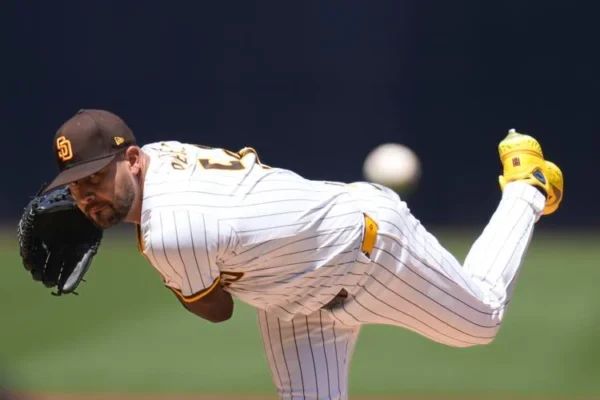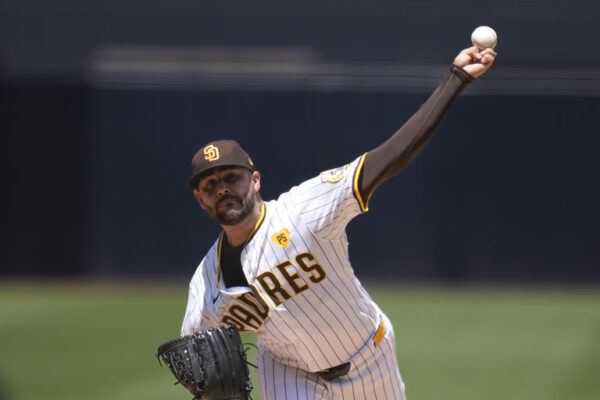How sustainable is Martin Perez’s early success as a Padre?

(AP Photo/Michael Laughlin)

The San Diego Padres looked into a multitude of options in the starting pitching market at the trade deadline.
A.J. Preller and his staff made the decision to acquire left-hander Martin Perez from the Pittsburgh Pirates.
Perez was coming off 16 starts where he posted a 5.20 ERA and 4.96 FIP across 83 innings, striking out 16.9% of batters and walking 8.6%. The Baseball Savant numbers weren’t particularly painting the nicest picture either.
However, Perez has been a revelation for the Padres in his first three starts as a Friar, securing his first win as a Padre against the Pirates on August 14.
Perez with PIT: 83 IP, 5.20 ERA, 4.96 FIP, 16.9% K Rate, 8.6 % BB Rate, .875 OPS against
Perez with SD: 18.1 IP, 1.96 ERA, 4.38 FIP, 29.6% K Rate, 4.2 % BB Rate, .555 OPS against
The numbers paint an image of two very different pitchers.
Perez’s strikeout and walk rates have gone from middling to ace-caliber almost overnight, so what exactly is the biggest change? For that, we need to look under the hood.
When a pitcher is traded from one organization to another, the new organization often has an idea of what they want to work with said pitcher to improve or maximize their performance. For Perez and the Padres, there was an idea of what the team wanted to work on. It is Padres pitching coach Ruben Niebla’s philosophy not to force a change onto a pitcher but rather to work with a pitcher in a collaborative process on said changes. The new pitching lab has undoubtedly aided in that regard.
When looking at Perez’s performances before the trade, there was a pattern in his pitch selection.
The southpaw leaned heavily on his sinker and cutter in Pittsburgh. There were only two starts in which he relied on something other than those two as his secondary offering. His sinker usage was in line with his 2022 and 2023 pitch usage. However, the emphasis on the cutter as the main secondary was changed from 2023 to 2024.
At first, it may have been perceived as pertaining to organizational philosophy, but of Pirates left-handers to toss at least 30 innings this season. None relied on the cutter as their main secondary. Starters Bailey Falter and Marco Gonzales leaned on their changeups as their main secondaries, as did reliever Josh Fleming (who was DFA’d on July 26). The lone exception is Aroldis Chapman, and he doesn’t lean on a cutter because… well… he can hit 104 mph with a filthy pairing of a slider and splitter.
Perez has shifted the use of his arsenal heavily since arriving in San Diego. The biggest difference is the uptick in the use of his curveball. In Pittsburgh, Perez used his curveball as either the least or the second least of his offerings, depending on the start. He never leaned on it more than 14% of the time outside of one start in April. In three games with the Padres, the curveball has seen a usage rate of 26.3%, 22.2%, and a season-high of 32.3% in his last start.

Paired with the uptick in usage is an uptick in results, as batters are hitting .053 against the curveball in his last three starts. In simpler terms, Perez has been “pitching backward”. In his time with the Padres, instead of leaning on his sinker for ground balls, this has correlated with more whiffs on his changeup.
The last change in his arsenal is the near-abandonment of his four-seam fastball.
The adjustment here looks to be part of the Padres’ organizational philosophy of pitchers leaning on their strengths. For Dylan Cease, that has been the way his fastball-slider combo tunnels. For Michael King, that has been the increased efficiency of his changeup. With Perez, the Padres have turned their focus on his curveball and changeup and how those pitches play off of one another. Therefore, this could lead to better results for Perez’s cutter and sinker if he is able to keep locating and generating whiffs.
In his three Padres starts, Perez has walked a minuscule 4.2% of batters faced compared to an 8.6% walk rate in the ‘Burgh. For a pitcher who does not have blistering velocity, location becomes increasingly important. Perez has found a balance between pitching aggressively and locating when he needs to for swings and misses.
Are these rates sustainable?
Well, Martin Perez has a 4.38 FIP in his 18.1 innings as a Padre, partly thanks to four home runs allowed. However, all four of those home runs have been of the solo variety. Perez has allowed only 11 hits in those 18.1 innings. While it is more likely Perez will post an ERA in the 3.00s or 4.00s by the time his tenure as a Padre is complete, there is still the chance he will keep up his current production. This sort of stretch has happened for pitchers traded at the deadline before, and a relatively recent example comes from a former Friar.
In 2019, Jordan Lyles started the year with- oh, the Pirates. In 17 first-half starts with the Pirates, Lyles had posted a 5.36 ERA. 4.79 FIP, and allowing 9.6 hits per nine innings. The cumulative result was an ERA+ of 81 or 19% below the league average. The Milwaukee Brewers, who were dealing with rotation woes at the 2019 deadline, traded minor league reliever Cody Ponce to re-acquire Lyles.
In 11 starts with the Brewers in 2019, Lyles posted a 2.45 ERA and 23.5% strikeout rate in 58.2 innings. His results added up to a mind-boggling 182 ERA+. This meant Lyles was 82% better than the league-average pitchers in those 11 starts. His FIP in that span was 4.42, and not many of his advanced numbers were really different from his time with the Pirates. Perez’s pitch usage wasn’t particularly different either, as it remained relatively consistent across the entire season. However, he was simply pitching better, making timelier pitches, and benefiting greatly from a .225 BABIP. Lyles went 7-1 in that span, with the Brewers going 10-1 in his 11 starts, as he gave the team a chance to win every time he took the mound for them.
How does this tie back to Martin Perez?
Well, even if Perez is outperforming his expected stats, even if his 29.6% strikeout rate, 1.96 ERA, and .167 BABIP are unsustainable, San Diego doesn’t need it to last 32 starts. The Padres merely need these numbers to continue for roughly eight to 11 more starts until the team achieves its goal of making it back to the playoffs and possibly winning a World Series title.
A born and raised San Diegan, Diego Garcia is a lifetime Padres fan and self-proclaimed baseball nerd. Diego wrote about baseball on his own site between 2021-22 before joining the East Village Times team in 2024. He also posts baseball content on his YouTube channel “Stat Nerd Baseball”, creating content around trades, hypotheticals, player analyses, the San Diego Padres, and MLB as a whole.
A 2024 graduate of San Diego State, Diego aims to grow as a writer and content creator in the baseball community.